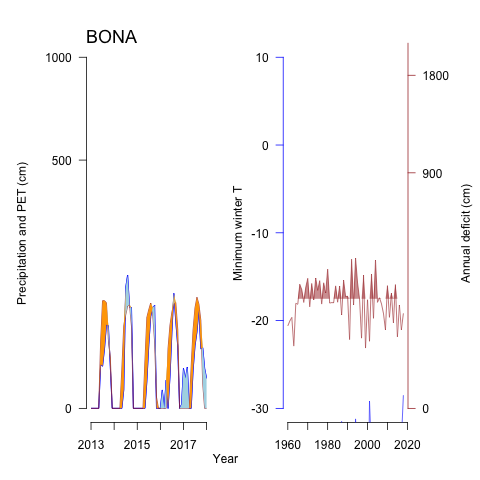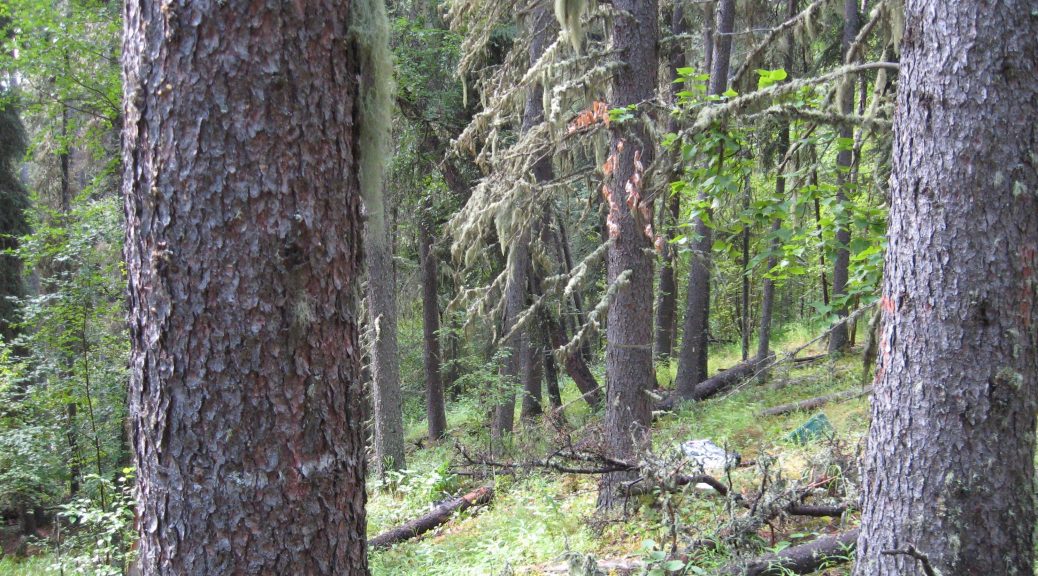Bonanza Creek (BONA)
Above: Mature white spruce forest in the BNZ uplands monitored as site UP3A (photo credit: BNZ LTER, 2008)
December 2018
The BNZ LTER program is based at the University of Alaska Fairbanks and was established in the mid-1980’s to study patterns and mechanisms of boreal forest succession following fluvial and fire disturbance. Some study site records pre-date the establishment of BNZ as part of the Long Term Ecological Research network, and were part of an earlier experimental forest program at Bonanza Creek led by researchers with the US Forest Service. To this day, USFS remains an active partner in funding and conducting research at BNZ. NEON uses the acronym BONA.
| Tree-years | Seeds | |
|---|---|---|
| Alnus incana | 0 | 50393 |
| Alnus viridis | 0 | 150155 |
| Betula neoalaskana | 2886 | 384667 |
| Larix laricina | 30 | 1360 |
| Picea glauca | 3913 | 76940 |
| Picea mariana | 1225 | 4120 |
| Populus balsamifera | 2138 | 0 |
| Populus tremuloides | 586 | 0 |
The principle masting species in the boreal forests of interior Alaska is white spruce (Picea glauca). John Zasada and Keith Van Cleve established sites for monitoring seed rain of white spruce in the 1950’s and 1960’s; these sites continue to be monitored as part of the BNZ LTER program, despite interruptions by wildfire or other natural processes. Other sites were explicitly established as part of the evolving BNZ LTER research design, in the late 1980’s and more recently in the past decade. For the MASTIF project, we are focusing on seed rain data collected at sites established prior to 1990, most of these with a continuous record up to the current year.

Results from studies of seed rain at BNZ can be found in earlier publications by John Zasada, Les Viereck, Keith Van Cleve, Terry Chapin and others, along with more recent syntheses that use the BNZ seed rain archive (see the list of publications below). Data are accessible through the BNZ LTER data archive.
The MASTIF project is using data from several floodplain (FP) and upland (UP) sites monitored within the BNZ site network:
- FP2A: early-mid succession, mostly alder with+ some birch and white spruce (1985-2017)
- FP3A: mid-succession, alder, birch, white spruce (1989-2006)
- FP4A: late succession, mostly white spruce (1986-2017)
- FP5A: late succession, mostly black spruce (1989-2017)
- UP2A: mid-succession, white spruce, birch (1989-2006)
- UP3A: late succession, white spruce, birch, alder (1968-2017)
Data on seed rain and viability have been collected for Betula neoalaskana (Alaskan paper birch), Larix laricina (larch), Picea glauca (white spruce), and Picea mariana (black spruce), depending on which species are present at a site. Study sites at BNZ are generally represented by a 50 x 60 m plot in which tree stems have been inventoried and mapped. Seeds are monitored by collecting seed fall each spring (after the winter seed dispersal period) within eight 0.25 m2seed traps. The contents of each seed trap collection are sorted in the lab and seeds viability is tested using germination trials (germination of seeds on moist filter paper over a one month period).
Climate data come from the LTER site.
Publications:
Chapin, F. S., III, Viereck, L. A., Adams, P., Van Cleve, K., Fastie, C. L., Ott, R. A., … Johnstone, J. F. (2006). Successional processes in the Alaskan boreal forest. In I. F.S. Chapin, M. Oswood, K. Van Cleve, L. A. Viereck, & D. L. Verbyla (Eds.), Alaska’s Changing Boreal Forest(pp. 100–120). Oxford: Oxford University Press.
McGuire, A. D., Ruess, R. W., Lloyd, A., Yarie, J., Clein, J. S., & Juday, G. P. (2010). Vulnerability of white spruce tree growth in interior Alaska in response to climate variability: dendrochronological, demographic, and experimental perspectives. Canadian Journal of Forest Research, 40(7), 1197–1209. https://doi.org/10.1139/X09-206
Roland, C. A., Schmidt, J. H., & Johnstone, J. F. (2014). Climate sensitivity of reproduction in a mast-seeding boreal conifer across its distributional range from lowland to treeline forests. Oecologia, 174(3), 665–677. https://doi.org/10.1007/s00442-013-2821-6
Usinowicz, J., Chang-Yang, C.-H., Chen, Y.-Y., Clark, J. S., Fletcher, C., Garwood, N. C., … Wright, S. J. (2017). Temporal coexistence mechanisms contribute to the latitudinal gradient in forest diversity. Nature, 550(7674), 105–108.
Van Cleve, K., Dyrness, C. T., Viereck, L. A., Fox, J. D., Chapin, F. S., III, & Oechel, W. C. (1983). Taiga ecosystems in Interior Alaska. BioScience, 33, 39–44.
Viereck, L. A., Dyrness, C. T., Van Cleve, K., & Foote, M. J. (1983). Vegetation, soils, and forest productivity in selected forest types in interior Alaska. Canadian Journal of Forest Research, 13, 703–720.
Wurtz, T. L., & Zasada, J. C. (2001). An alternative to clear-cutting in the boreal forest of Alaska: a 27-year study of regeneration after shelterwood harvesting. Canadian Journal of Forest Research, 31, 999–1011.
Zasada, J. (1986). Natural regeneration of trees and tall shrubs on forest sites in interior Alaska. In K. Van Cleve, F. S. Chapin III, P. W. Flanagan, L. A. Viereck, & C. T. Dyrness (Eds.), Forest ecosystems in the Alaskan taiga(pp. 44–73). New York: Springer-Verlag.
Zasada, J. C. (1985). Production, dispersal, and germination of white spruce and paper birch and first-year seedling establishment after the Rosie Creek Fire. In G. P. Juday & C. T. Dyrness (Eds.), Early results of the Rosie Creek fire research project, 1984(Vol. Misc. Pub. 85-2, pp. 34–37). Fairbanks, AK: Agricultural and Forestry Experiment Station, University of Alaska Fairbanks.
Zasada, J. C., Sharik, T. L., & Nygren, M. (1992). The reproductive process in boreal forest trees. In H. H. Shugart, R. Leemans, & G. B. Bonan (Eds.), A systems analysis of the global boreal forest.(pp. 85–125). Cambridge: Cambridge University Press.


